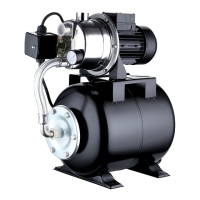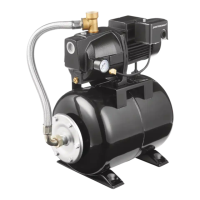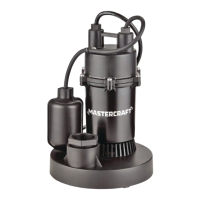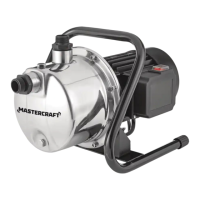Electrical 8
HHaazzaarrddoouuss vvoollttaaggee.. CCaann sshhoocckk,, bbuurrnn,, oorr kkiillll.. CCoonnnneecctt ggrroouunndd
wwiirree bbeeffoorree ccoonnnneeccttiinngg ppoowweerr ssuuppppllyy wwiirrees
s.. UUssee tthhee wwiirree ssiizzee ((iinncclluuddiinngg tthhee
ggrroouunndd wwiirree)) ssppeecciiffiieedd iinn tthhee wwiirriinngg cchhaarrtt..
If possible, connect the pump to a
separate branch circuit with no other appliances on it.
EExxpplloossiioonn hhaazzaarrdd.. DDo
o nnoott ggrroouunndd ttoo aa ggaass ssuuppppllyy lliinnee..
WWIIRRIINNGG CCOONNNNEECCTTIIOONNSS
FFiirree hhaazzaarrdd..
Incorrect voltage can cause a fire or seriously dam-
age the motor and voids the warranty. The supply voltage must be within
±10% of the motor nameplate voltage.
NNOOTTIICCEE::
Dual-voltage motors are factory wired for 230 volts. If necessary,
reconnect the motor for 115 volts, as shown. Do not alter the wiring in sin-
gle voltage motors.
Install, ground, wire, and maintain your pump in compliance with the
National Electrical Code (NEC) or the Canadian Electrical Code (CEC), as
applicable, and with all local codes and ordinances that apply. Consult
your local building inspector for code information.
CCoonnnneeccttiioonn PPrroocceedduurree::
Step 1. Connect the ground wire first as shown in Figure 6. The ground
wire must be a solid copper wire at least as large as the power
supply wires.
Step 2. There must be a solid metal connection between the pressure
switch and the motor for motor grounding protection. If the pres-
sure switch is not connected to the motor, connect the green
ground screw in the switch to the green ground screw under the
motor end cover. Use a solid copper wire at least as large as the
power supply wires.
Step 3. Connect the ground wire to a grounded lead in a service panel, to a
metal underground water pipe, to a metal well casing at least ten
feet (3M) long, or to a ground electrode provided by the power
company or the hydro authority.
Step 4. Connect the power supply wires to the pressure switch as shown in
Figure 6.
YYoouu hhaavvee jjuusstt ccoommpplleetteedd tthhee wwiirriinngg ffoorr yyoouurr ppuummpp..
PPlleeaassee ggoo ttoo PPaaggee 99 ffoorr ssttaarrttuupp pprreeppaarraattiioonnss..
DDIISSTTAANNCCEE IINN FFEEEETT((MMEETTEERRSS)) FFRROOMM MMOOTTOORR TTOO SSUUPPPPLLYY
00 -- 110000 110011 -- 220000 220011 -- 330000 330011 -- 440000 440011 -- 550000
MMaaxx.. LLooaadd BBrraanncchh FFuussee
((00 -- 3300)) ((3311 -- 6611)) ((6622 -- 9911)) ((9922 -- 112222)) ((112233 -- 115522))
MMooddeell VVoollttss AAmmpp RRaattiinngg AAmmpp AAWWGG WWIIRREE SSIIZZEE ((mmmm
22
))
62-3525-6 115 9.4 15 14 (2) 10 (5.5) 10 (5.5) 6 (14) 6 (14)
62-4003-2 115 9.4 15 14 (2) 10 (5.5) 10 (5.5) 6 (14) 6 (14)
62-3526-4 115/230 14.8/7.4 20/15 14/14 (2/2) 12/12 (3/3) 10/10 (5.5/5.5) 8/8 (8.4/8.4) 8/8 (8.4/8.4)
Wiring Chart – Recommended Wire and Fuse Sizes
For parts or assistance, call Customer Service at 1-877-455-5508
